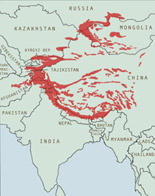A community collaborating to ensure the survival of the snow leopard in the wild.
The Snow Leopard Network (SLN), is a collaborative knowledge network of individuals, conservation organisations, NGOs and government agencies from all over the globe working on snow leopard conservation. It began in 2002 at the Snow Leopard Survival Summit in Seattle, Washington, USA as a means for snow leopard conservationists to co-operate on research and to address the challenges impacting the snow leopard’s survival while ensuring the livelihood opportunities of local people in snow leopard range countries.
Membership
Membership in the Snow Leopard Network is free of charge and open to any individual or organization, worldwide, interested or active in snow leopard conservation. Full membership is open to individuals and organisations actively engaged in snow leopard research and conservation while affiliate membership is available to interested members of the public and students. By 2015 the SLN had over 500 members, both individual and institutional.
Snow Leopard Survival Strategy
In 2003 the SLN produced the first Snow Leopard Survival Strategy 2003, a report which presents a co-ordinated strategy for ensuring the endangered cat’s survival in all 12 range countries. This key document was updated and rewritten and published as the Snow Leopard Survival Strategy 2014.1. It incorporated new research material on snow leopard status, threats and conservation best practices collected by members, academic institutions, range country government authorities and NGO groups.
The Snow Leopard Survival Strategy is also available as a living document website in order to incorporate new critical information.
Snow Leopard Conservation Grant program
The Snow Leopard Network runs a Conservation Grant program disbursing up to $60,000 – $80,000 of research funds to institutions and researchers each year.
Snow Leopard Bibliography
Snow Leopard Network maintains a bibliographic database of over 1300 references and more than 1500 full text documents, primarily of scientific nature, concerning the snow leopard and its habitat. This information has been compiled for the sole purpose of sharing and making the information available to concerned government officials, individuals, conservationists and researchers globally.



